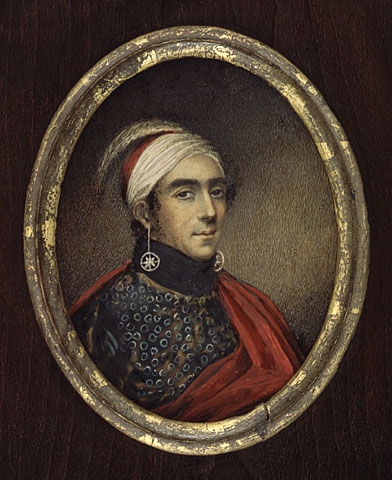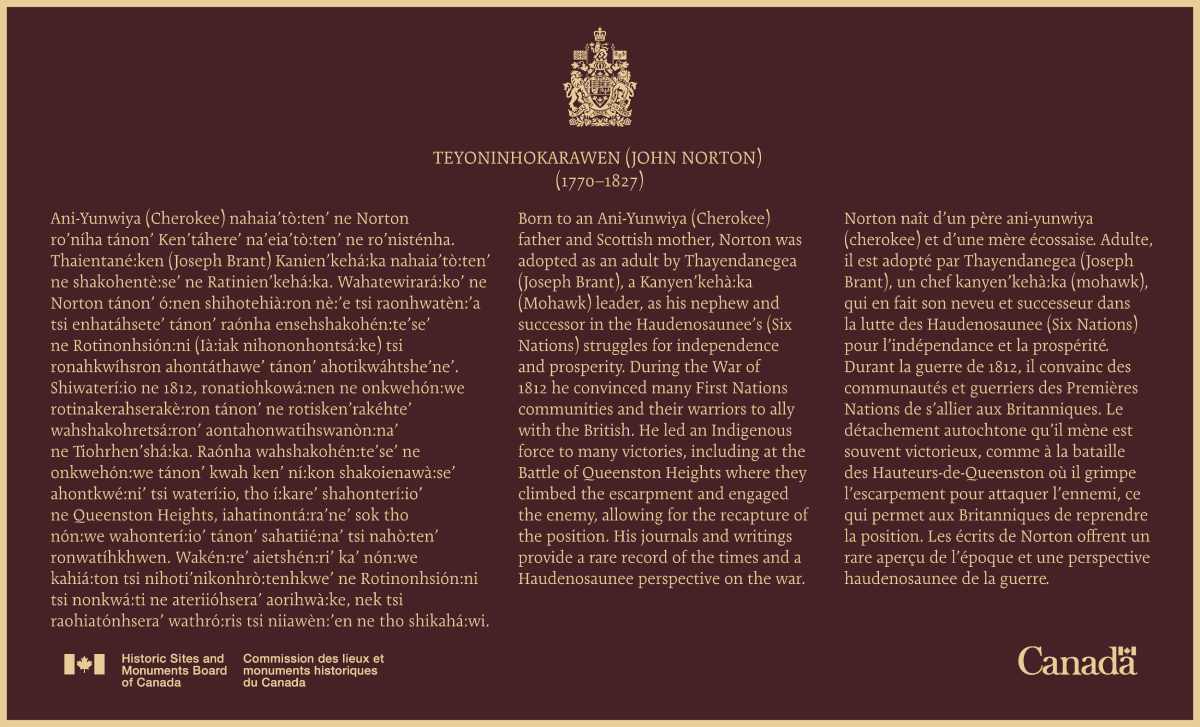Teyoninhokarawen (John Norton) (1770–1827) National Historic Person

© Library and Archives Canada / 1984-119-1 / Copyright expired
Teyoninhokarawen (John Norton) was designated as a national historic person in 2011.
Historical importance: a great political and military leader among the Grand River Iroquois before, during and after the War of 1812.
Commemorative plaque: will be installed at Queenston Heights Park, Niagara-on-the-Lake, OntarioFootnote 1
Teyoninhokarawen (John Norton) (1770–1827)
Born to an Ani-Yunwiya (Cherokee) father and Scottish mother, Norton was adopted as an adult by Thayendanegea (Joseph Brant), a Kanyen’kehà:ka (Mohawk) leader, as his nephew and successor in the Haudenosaunee’s (Six Nations) struggles for independence and prosperity. During the War of 1812 he convinced many First Nations communities and their warriors to ally with the British. He led an Indigenous force to many victories, including at the Battle of Queenston Heights where they climbed the escarpment and engaged the enemy, allowing for the recapture of the position. His journals and writings provide a rare record of the times and a Haudenosaunee perspective on the war.

Teyoninhokarawen (John Norton) (1770–1827)
John Norton was born in Scotland on 16 December 1770, the son of a Scottish mother and an Ani-Yunwiya (Cherokee) father who was born in Kuwoki (modern South Carolina) and partly raised in Scotland. Norton became a great political and military leader among the Haudenosaunee (particularly the Six Nations of the Grand River) before, during and after the War of 1812. Adopted as an adult by Thayendanegea (Joseph Brant) as his nephew, Norton served as his second-in-command, and later as his successor. He convinced many First Nations communities and their warriors to ally with the British during the War of 1812, leading an Indigenous force to many victories. After the war, Norton served as a strong advocate for First Nations land rights, quality of life, and cultural transition. His journals and writings provide a rare record of the times and a Haudenosaunee perspective on the war.

© Beaverbrook Collection of War Art / Canadian War Museum
Educated in Scotland, Norton enlisted with the 65th Foot and arrived at Québec with the regiment in 1785. In 1790, he became a schoolmaster in the Kanien’kehá:ka (Mohawk) settlement of Tyendinaga, at the Bay of Quinte, and four years later an interpreter in the Indian Department at Niagara, Upper Canada. There, he was befriended by Kanien’kehá:ka chief Thayendanegea who adopted him as his nephew and successor in the Haudenosaunee’s struggles for independence and prosperity. Upon adoption, Norton was given the name Dowwisdowwis (“the Snipe”). In 1799, chiefs of his clan gave him the name Teyoninhokarawen (“It keeps the door open”), a rank conferring the powers of emissary in diplomatic affairs and chieftain in war. In 1804, Teyoninhokarawen journeyed to London, England, to convince the Privy Council to support Haudenosaunee land rights, in opposition to the Indian Department. After Thayendanegea’s death in 1807, Teyoninhokarawen was appointed as his successor. Frustrated by continuing tensions with the Indian Department and internal political struggles at Grand River, he set out on a long journey to the land of the Ani-Yunwiya in Ohio, Kentucky, Tennessee, and Georgia.
Upon the outbreak of the War of 1812, Teyoninhokarawen convinced many First Nations chiefs, clan mothers, and warriors to ally with the British. He led an Indigenous force at Detroit and in numerous battles in the Niagara campaign. His great military achievement was at Queenston Heights in October 1812 when he and his men climbed the escarpment and engaged the enemy, allowing for the recapture of the position. He also led a force at Fort George, covered the British retreat towards Burlington Heights, and fought at Stoney Creek and in the Action at Butler’s Farm. He retrieved British medical supplies hidden near Fort George and led warriors in the battles of Chippawa and Lundy’s Lane and the siege of Fort Erie. Distinguishing himself in battle, he received the title of “Captain of the Confederate Indians” from the British. After the War of 1812, Teyoninhokarawen and his wife Karighwaycagh (Catherine) moved to Grand River, taking up farming and advocating for First Nations veterans, widows, and orphans.
Teyoninhokarawen also left a rich literary legacy. He translated the Gospels of St. John and St. Matthew into Kanien’kéha (the Mohawk language), wrote a remarkable account of his 3,000 km journey to Ani-Yunwiya country, detailing the customs, mythology, and history of the Nation, completed a rare history of the Haudenosaunee Confederacy, and produced a narrative of the War of 1812. According to an Ani-Yunwiya Mission Diary entry at Oochgeelogy, Georgia, he died in 1827.
This press backgrounder was prepared at the time of the plaque unveiling in 2024.
The National Program of Historical Commemoration relies on the participation of Canadians in the identification of places, events and persons of national historic significance. Any member of the public can nominate a topic for consideration by the Historic Sites and Monuments Board of Canada.
- Date modified :